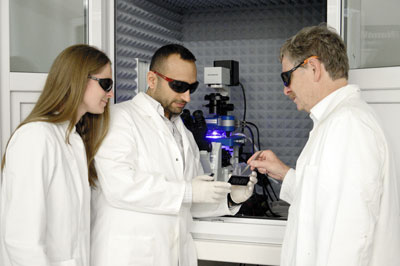| Posted: Jan 13, 2016 |
Researchers control cell adhesion using light
(Nanowerk News) A cell is rarely on its own, because cells require good contacts to communicate with one another, to differentiate from others and to multiply. For this, cells have developed sophisticated mechanisms, the details of which are still widely unknown.
|
|
In order to get a little closer towards unravelling the mystery of cell adhesion, the two chemists, Michelle Holz and Grace Suana, inserted a light-sensitive switch into molecules which cells like to adhere to, and then attached these to a glass surface. If this surface is then exposed to even a few seconds of UV light, the 'adhesion molecules' pull back and the cells can only attach themselves with difficulty. Irradiation with visible light reverses the process and the cells join together with the molecules again.
|
|
"In our model system we are able to control when and where cells adhere to in an extremely precise way", says Professor Rainer Herges from the Otto Diels Institute of Organic Chemistry.
|
 |
| Investigations using an atomic force microscope showed that the cell adhesion can be turned on and off in a controlled manner. In the photo (from the left): Christine Selhuber-Unkel, Laith Kadem and Rainer Herges.
|
|
The scientists used an atomic force microscope to test the system. This device is so sensitive that it is possible to determine the minute adhesive power of a single cell with great precision. Professor Christine Selhuber-Unkel and her doctoral candidate, Laith Kadem, from the Institute for Materials Science attached living connective tissue cells to a tiny, movable metal needle and detected its adhesive power to the switchable surfaces. This enabled them to verify the surfaces' switching function.
|
|
These research findings from Kiel ("Rapid Reversible Photoswitching of Integrin-Mediated Adhesion at the Single-Cell Level") could help us to optimise the use of cell cultures in future. After they have grown on the surfaces, the cells are often mechanically 'harvested'. This rough treatment often causes lots of cells to die, making the culture useless for medical application. This more gentle removal using light could help solve this problem. Precisely controllable, non-invasive procedures are particularly advantageous in cell breeding in computer-controlled biochips.
|
|
This work results from the Collaborative Research Centre (CRC) 677 ''Function by Switching'', funded by the Deutsche Forschungsgemeinschaft (German Research Foundation, DFG). Over 100 scientists worked on this showcase project in Kiel to develop switchable molecular machines.
|

